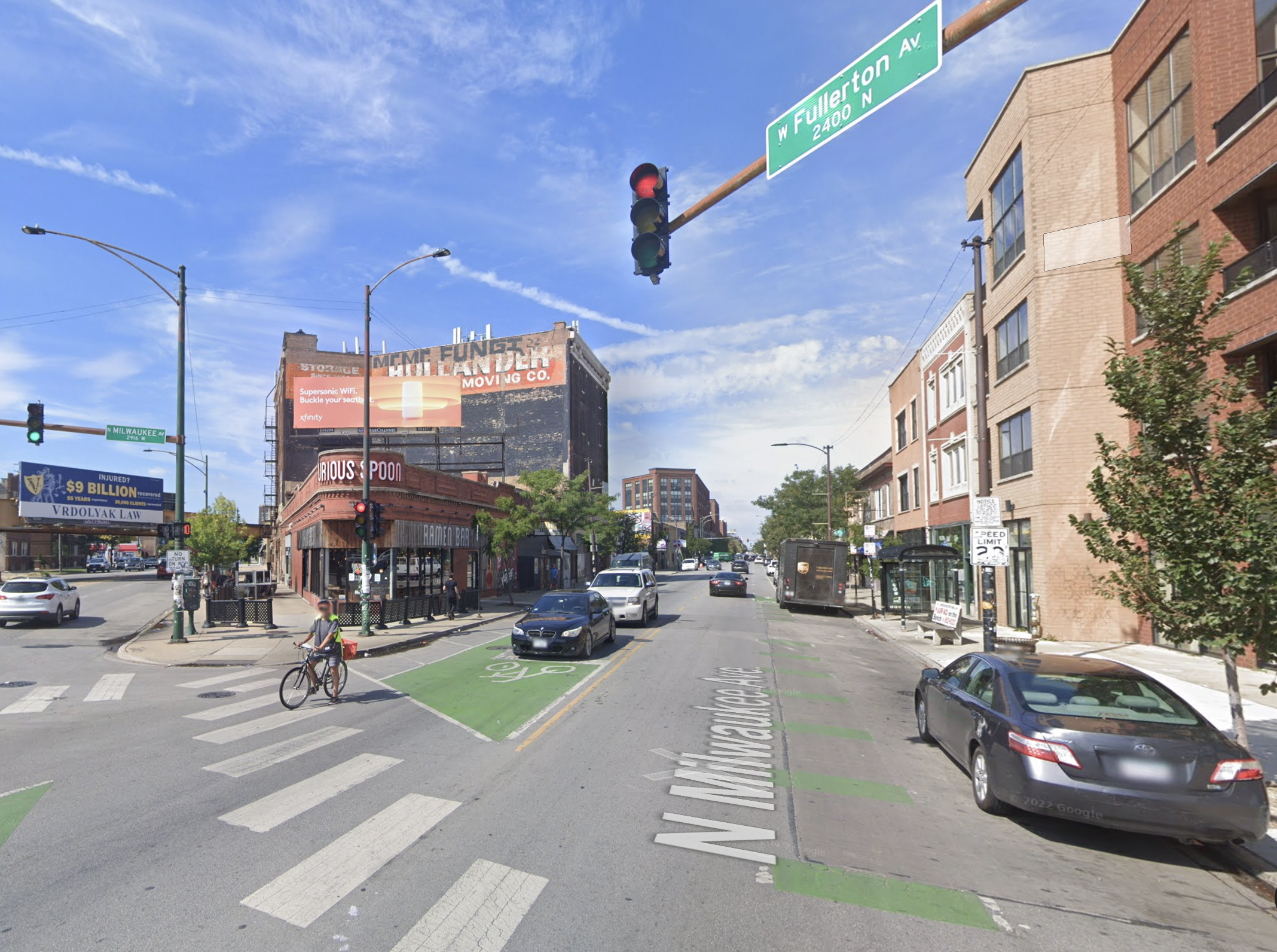
Earlier this week, Ald. Daniel La Spata (1st), held an infrastructure night meeting at the Lincoln Lodge, 2040 N. Milwaukee Avenue in Logan Square. As expected, the walk/bike/transit-friendly alderperson, his staff, and Chicago Department of Transportation representatives had announcements about upcoming sustainable transportation projects in the district.
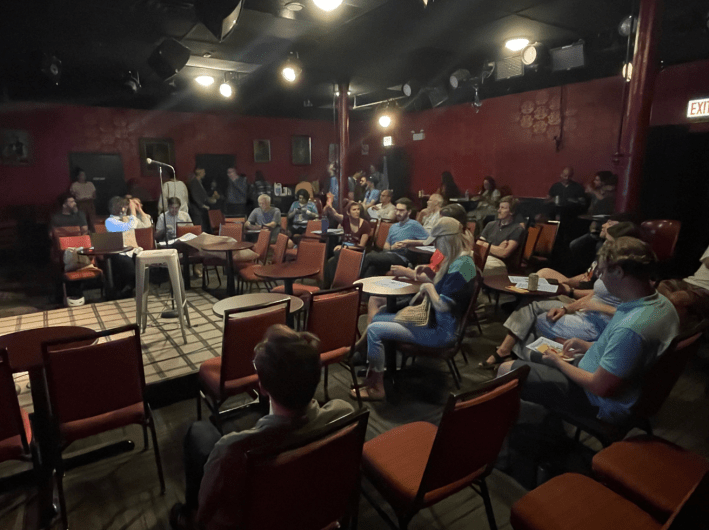
New bikeways on Milwaukee and California avenues
1st Ward Chief of Staff Nicholas Zettel shared the good news that the existing protected bike lanes on Milwaukee Avenue in Logan Square will be extended northwest later this year. The new stretch will run 0.6 miles, from California Avenue (2800 W., Milwaukee is 2300 N. there) to the traffic circle at Logan Boulevard (2600 N.) and Kedzie Avenue (3200 W.).
"There are some conspicuous little [protected bike lane] vacancies on Milwaukee Avenue right now in Logan Square," Zettel noted. "There are only a couple of areas where there are not bike lanes. So there are now protected bike lanes going in on the northern end of Logan Square. This is something that [CDOT] has spent great effort on." The project will be coordinated with the department's current project to make the traffic circle more people-friendly, including a new plaza next to the Logan Square Blue Line station.
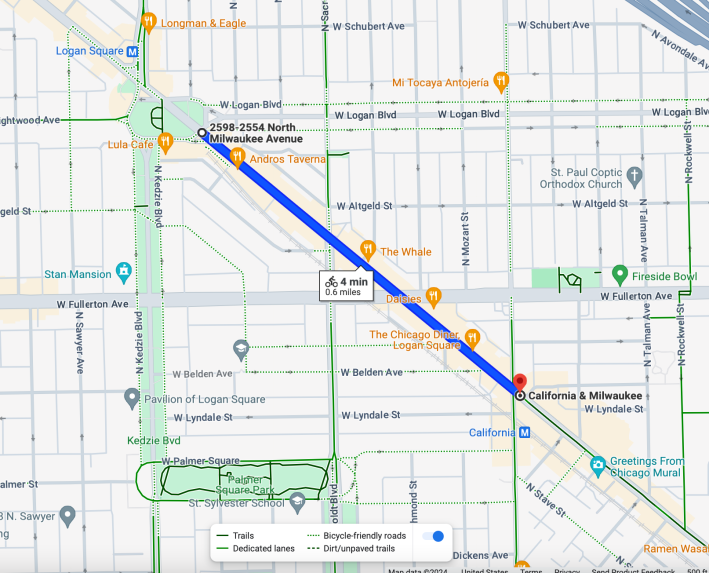
The Milwaukee protected lanes extension means there will be PBLs on the Avenue all the from North and Damen avenues (1600 N., 2000 W.) in West Town, to the traffic circle, a two-mile stretch. To accommodate the new bikeway segment, existing car parking spaces on the south side of Milwaukee between California and Logan/Kedzie will be converted. The same approach, although sometimes controversial, was used successfully on other stretches of Milwaukee between North/Damen and California.
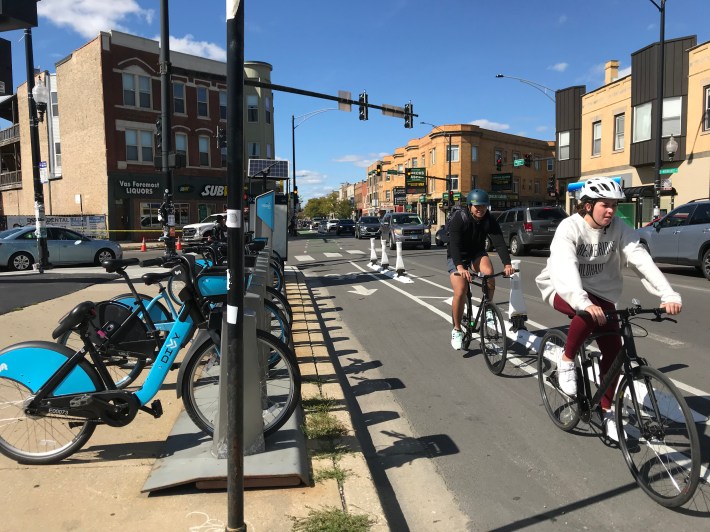
Edwin Serna, a CDOT SAFE Ambassadors, noted at the 1st Ward meeting that such bike projects also make things safer for people on foot. The protected lanes shorten crossing distances, and often include curb extensions and/or pedestrian islands. "That's one of the big benefits when we're doing protected bike lanes," he said. "We can really cut down... the amount of [road width where] somebody crossing the street is exposed to moving traffic. That's one reason why we see really big decreases in crashes related to people walking."
According to the transportation department, in the first full year after CDOT installed the PBLs between Western and California, traffic crashes dropped on that segment by 50 percent, and there were no pedestrian crashes.
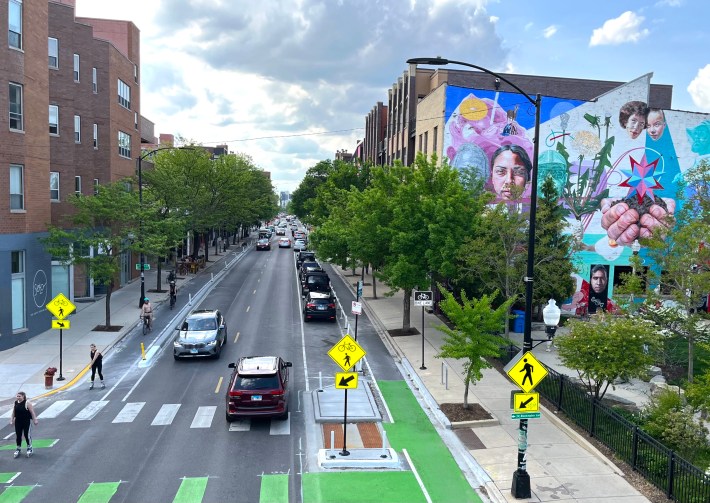
Unfortunately, in 2021 neighboring alderperson Carlo Ramirez-Rosa (35th) choose not to have CDOT install protected lanes as part of a streetscape project on Milwaukee northwest of the traffic circle to Belmont Avenue (3200 N.) The decision was based on a desire to retain all on-street parking on local retail strips.
However parking conversions for PBLs have worked well on other busy sections of Milwaukee, as long ago as 2013 in River North. Milwaukee is Chicago's busiest biking street, and it's seen way too many serious and fatal bike crashes in recent years, so it needs physical protection on its entire length within Chicago.
To Ald. Ramirez-Rosa's credit, he has more recently allowed the installation of successful PBLs like the ones on Belmont Avenue (3200 N.) in Avondale, and a few blocks of the Milwaukee PBL extension are in his ward. He's also splitting the cost of the following upcoming bikeway with Ald. La Spata. (Both of the bike bikeway projects discussed in this article are funded by the local ward's discretionary "menu money" – more on that in a bit.)
CDOT is striping mostly non-protected bike lanes on a mile of California Avenue between Belmont and Fullerton avenues. Block Club Chicago's Ariel Parrella-Aureli reported that, to save money, only the section of California under the Kennedy Expressway, between Schubert Avenue (2700 N.) and George Street (2900 N.) will have concrete-protection. However, at the meeting CDOT Complete Streets Planning Manager Brad Huff said physical protection could be added to the rest of this stretch in the future. The new California bikeway should also be completed this year.

This year, CDOT will also be installing four new bus boarding islands on Milwaukee in Wicker Park and Logan Square, Block Club reported.
Participatory budgeting
Nick Zettel also discussed the ward's upcoming participatory budgeting election "We have, for the first time ever, a specific sort of 'bricks and sticks' position that is specifically working on infrastructure, buildings, and all of that," he said. "Thanks to the City Council's budget advocacy, ward offices gained an extra staffer in this year's budget... Having that extra employee allows us to do more proactive stuff."
1st Ward resident Hammad Imam said he appreciates that the participatory budgeting process lets constituents have a say in how the district's annual $1.5 million in menu money is spent. "I like seeing... if there's a price benefit to compare apples to apples, what things are more cost-effective, how certain improvements might cost more than other improvements."
If you live in the 1st Ward and are interested in getting involved with the infrastructure decisions, you can email zoning[at]the1stward[dot]com. Meeting attendees were also invited to vote on what they would like to see on a mentimeter.com page.
The most popular choice for intersections that need infrastructure improvements was "Western and ANYthing." The top choice for what Menu funds should prioritize was sidewalk repairs. The most votes for infrastructure would benefit pedestrian and traffic safety the most was protected bike lanes. And tree planting was the most popular choice for beautifying the Ward.
Vision Zero strategies
At the 1st Ward meeting, Ald. La Spata also discussed current Vision Zero efforts he is pursing as chair of the City Council's Committee on Pedestrian and Traffic Safety. He noted that Vision Zero is "the aspiration and, in the case of Evanston, for example, the achievable reality of zero traffic fatalities." He pointed out that, thankfully, so far this year there have been no reported bike crash deaths on Chicago streets. He added that this is the second year in a row that the 1st Ward has experienced zero traffic fatalities.
"The harsh reality that we have to talk about is, in no year since 2016 has the City of Chicago experienced fewer than 100 traffic fatalities in any given year," Ald. La Spata added. "And they still have been predominantly in Black and Brown, and South and West side communities. So it tells us a lot about the work that we need to do to help everyone get home safely at the end of the day... whether you're riding, rolling, or driving through the city."
2023 Chicago pedestrian and bike fatalities mostly occurred in Black and Latino communities on the South and West sides.
La Spata noted that his committee introduced three pieces of legislation at the last council meeting to help Chicago achieve Vision Zero. The first would lower the city's default speed limit from 30 to 25 mph. The second is to establish a system allowing citizens to submit photo evidence of vehicles blocking bus and bike lanes to the 311 system, which would automatically issue tickets to the owners.

The third ordinance would establish a working group to evaluate Chicago's traffic enforcement structure to create a more equitable system. In January 2022, a University of Illinois Chicago study found that while the city's traffic cameras improved safety, a disproportion number of the vehicles recorded speeding or running reds were registered in majority Black or Latino communities. The City responded with a pilot offering half-off discounts on traffic citations for lower-income residents, and a ticket debt forgiveness program.

Ald. La Spata said he also wants to see revenue from Chicago's camera tickets dedicated to redesigning streets to encourage safe driving, so there's less need for enforcement in the first place.
What's going on with the Augusta PBLs?
After the meeting, Streetsblog asked Ald. La Spata for an update on efforts by disgruntled drivers to water down the design of the new Augusta Boulevard (1000 N.) protected bike lanes in West Town. While the bikeway is mostly located in the 1st Ward, official discussion of this possibility has taken place in the 23rd Ward, represented by Ald. Gilbert Villegas.
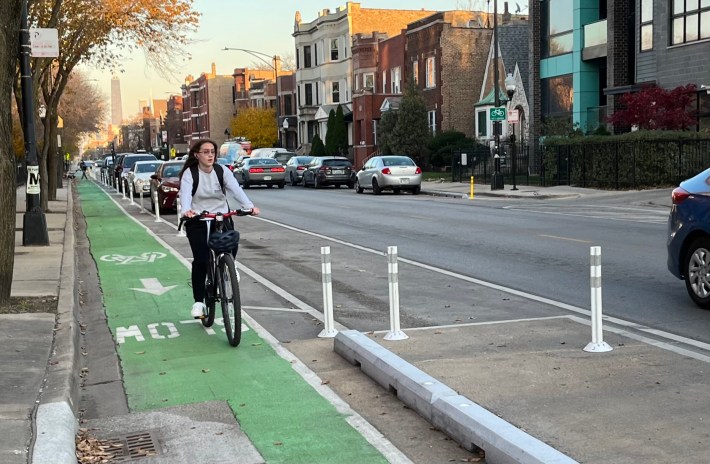
Ald. La Spata didn't offer any updates on what's happening with that conversation outside of his district. "I'll just be blatant about," he said. "I would not support any efforts to water down or change the infrastructure design, if it wasn't grounded in improving the safety of cyclists and pedestrians. And I have the fullest trust that CDOT gave us the absolutely design that they could."
Streetsblog Chicago will check in with Ald. Villegas in the near future to make sure a good protected bikeway won't get downgraded.

Did you appreciate this post? Please consider making a tax-deductible donation, to help keep Streetsblog Chicago's sustainable transportation news and advocacy articles paywall-free.
